Abstract
Intravenous hyperalimentation was done in 11 underweight adults whose body weight (body wt) was less than 85 percent of ideal. For the first 6 days, "complete formula" was infused furnishing per kilogram ideal body wt per day: 15 g glucose, 0.40 g N, 0.018 g P, 2.4 meq K, 3.0 meq Na, 2.3 meq C1, 0.5 meq Mg, 0.45 meq Ca, and 50 ml H20. Patients gained weight at an average rate of 9.0 g/kg ideal body wt/day and showed average balances/kilogram ideal body wt/day as follows: plus 0.14 g N; plus 0.012 g P; plus 0.43 meq K; plus 0.49 meq Na; plus 0.37 meq Cl; and plus 0.085 meq Ca. Application of standard equations to the elemental balances indicated weight gain consisted of 35-50 percent protoplasm, 35-50 percent extracellular fluid, 5-25 percent adipose tissus, and less than 1 percent bone. Withdrawas of N, P, Na, or K impaired or abolished retention of other elements. Removal of N halted retention P, K, Na and C1; withdrawal of K stopped retention of N and P; and removal of Na or P interrupted retention of all other elements. Weight gain continued at a rate of 1.4-3.1 g/kg ideal body wt/day despite zero or negative elemental balances of N, K, P, and sometimes Na and C1. Calculations showed that weight gain during infusion of fluids lacking N, P, K, or Na consisted largely of adipose tissue, with little or no contribution by protoplasm or extracellular fluid. Data show that repletion of protoplasm and extracellular fluid of wasted adults by intravenous hyperalimentation is retarded or abolished if N, P, Na, or K is lacking. Repletion of bone mineral does not occur in absence of Na or P but proceeds in absence of N, P, K, or Na. Thus, quality of weight gained by underfed adult patients during hyperalimentation depends on elemental composition of the infusate.
Full text
PDF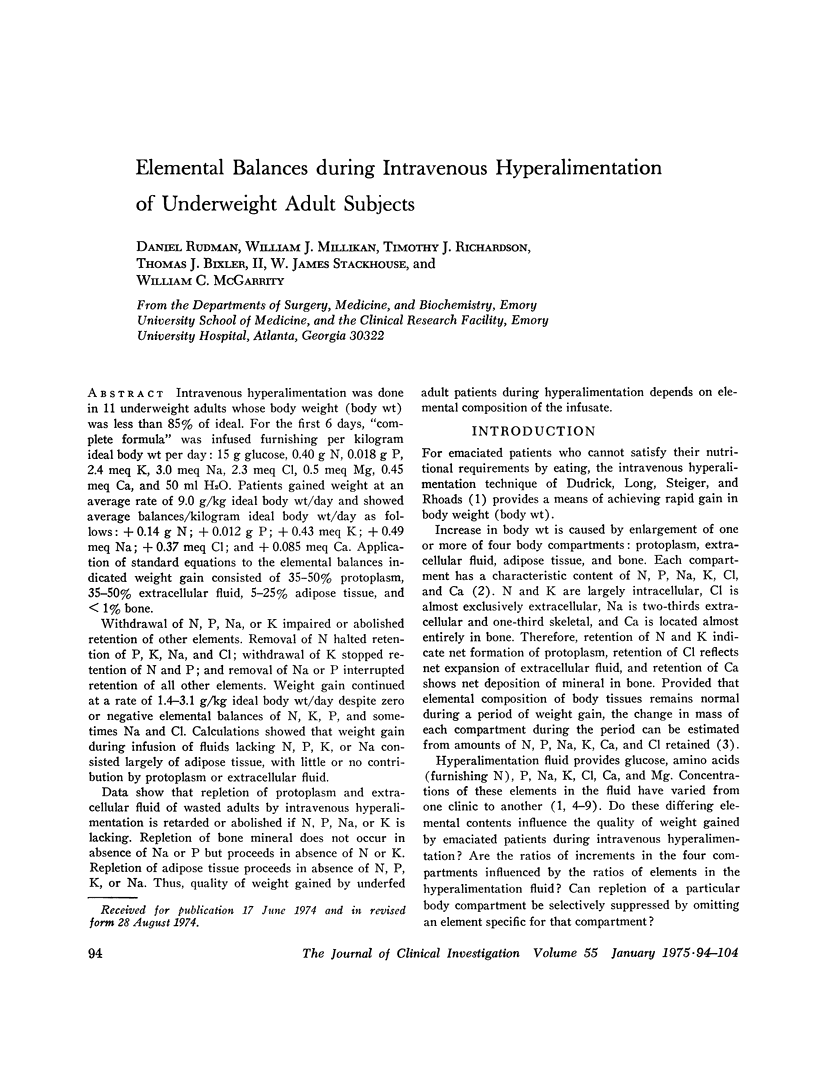
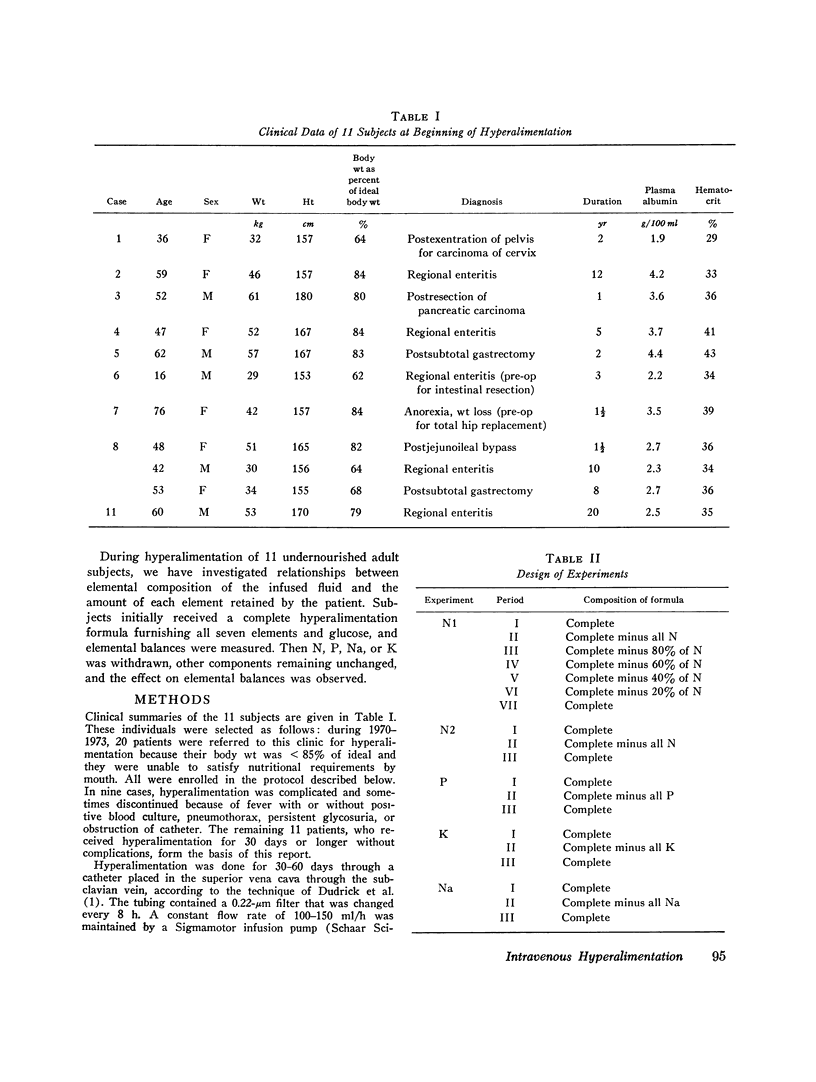
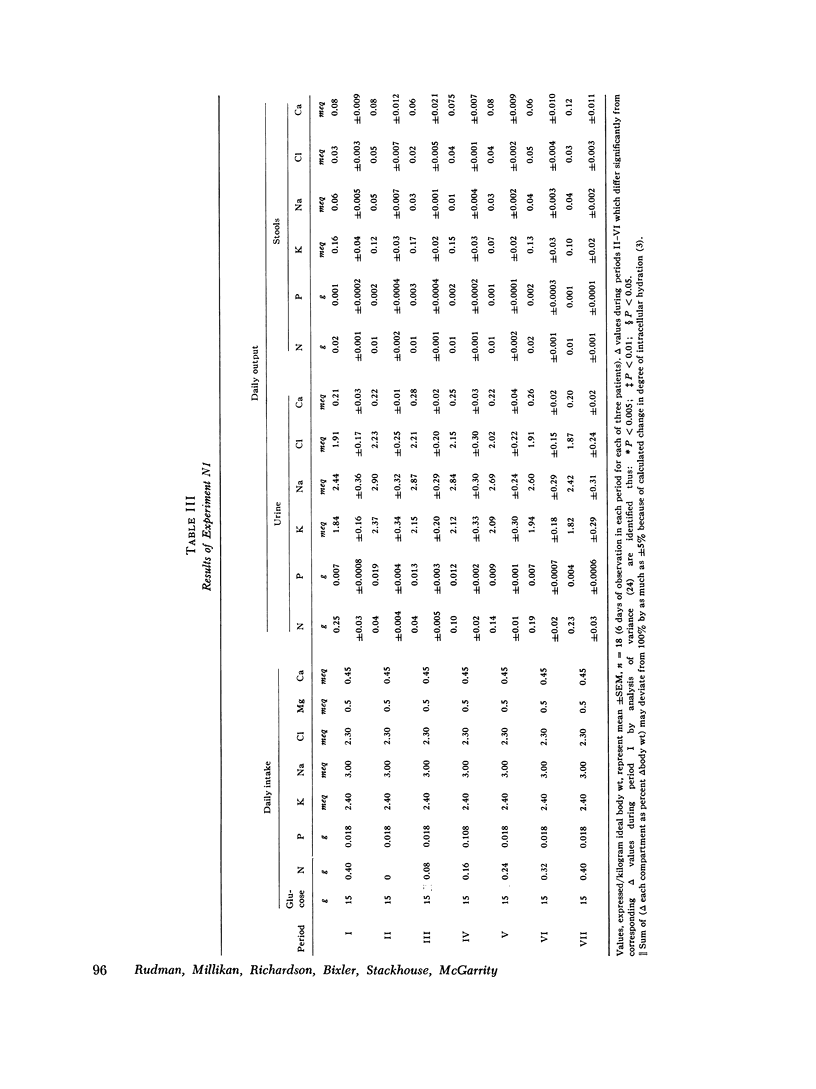
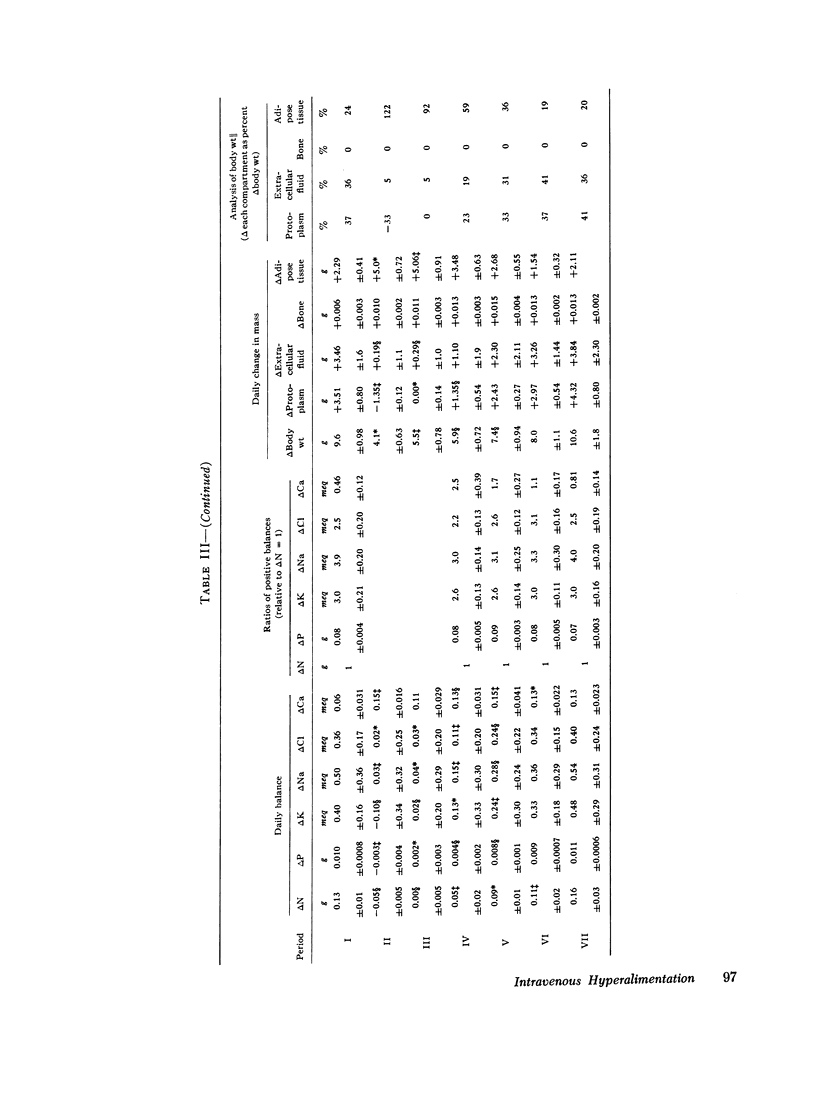
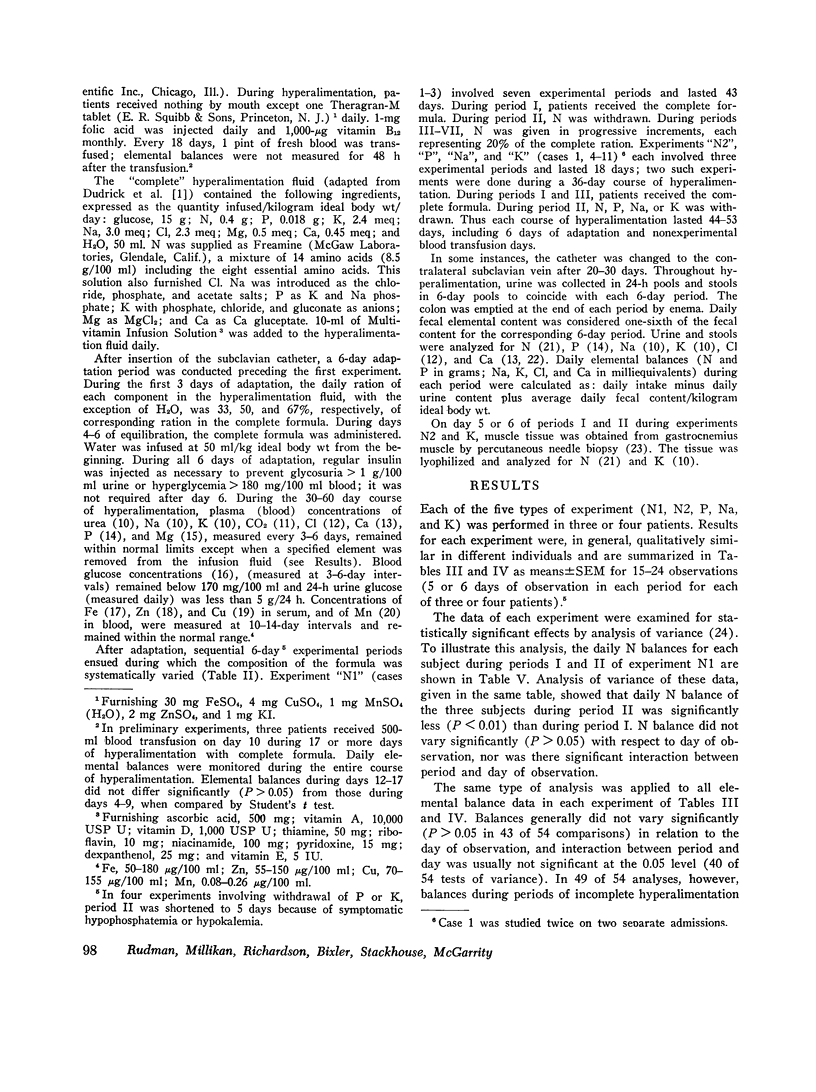
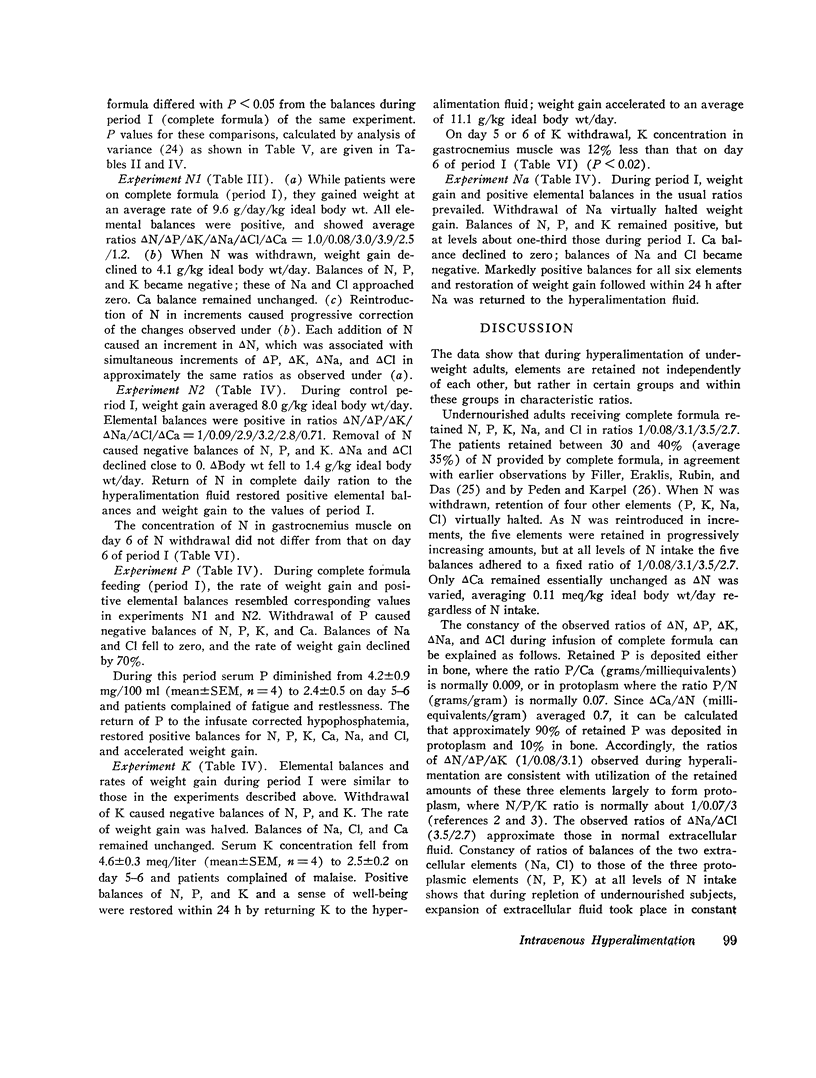
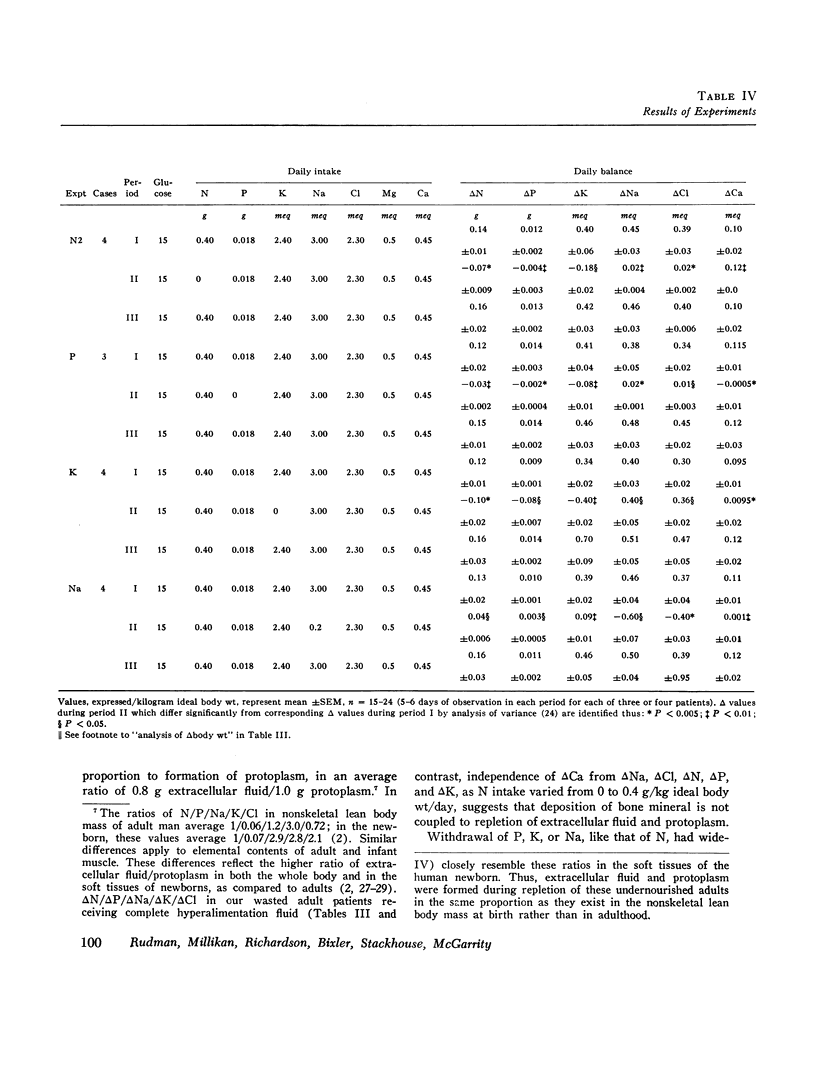
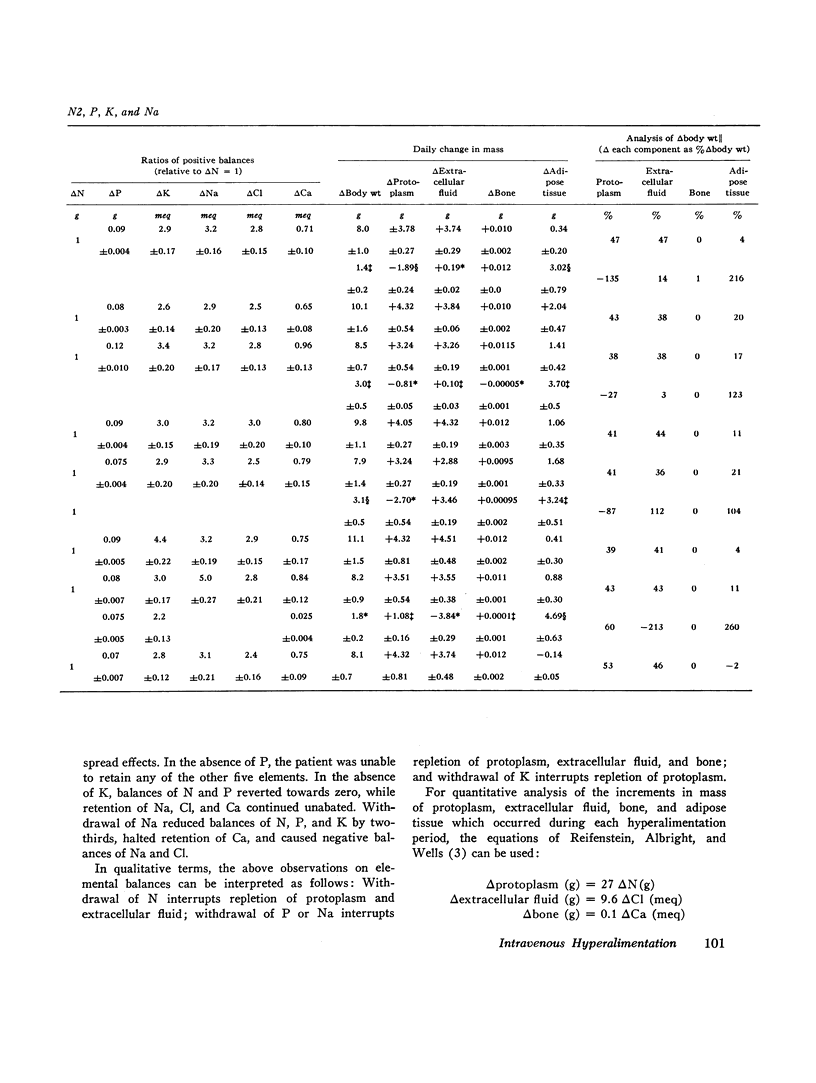
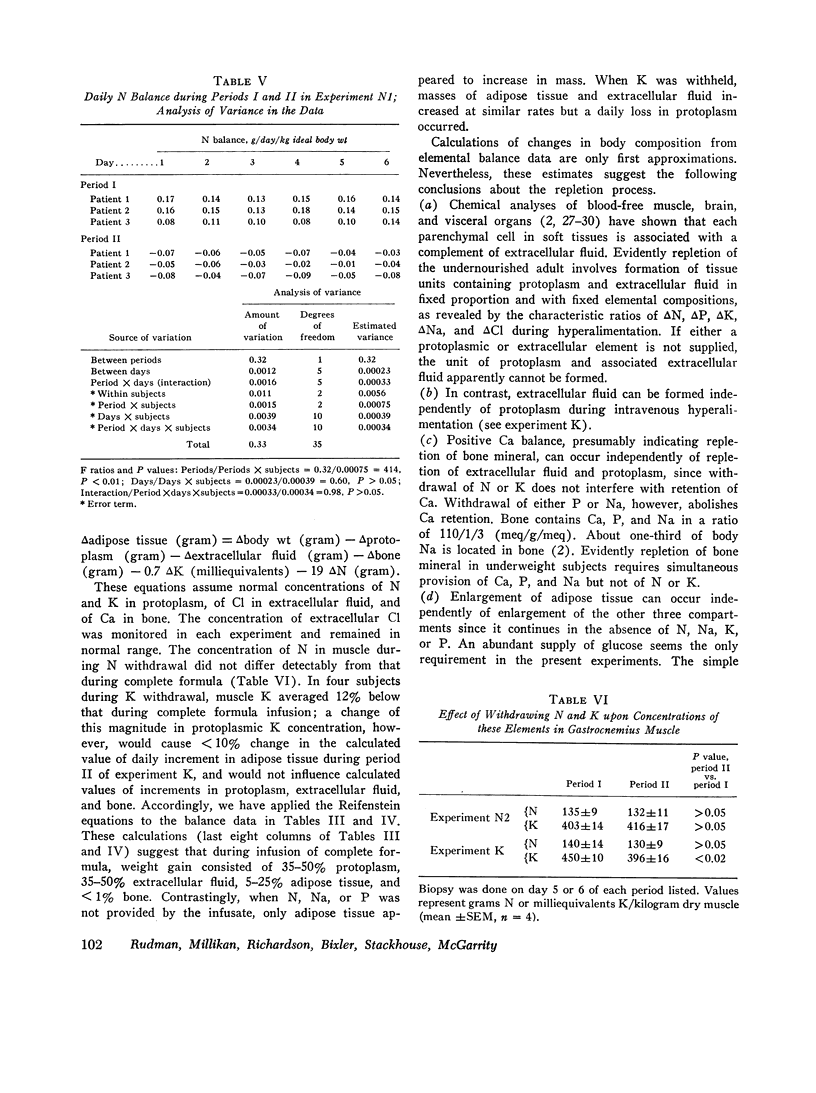
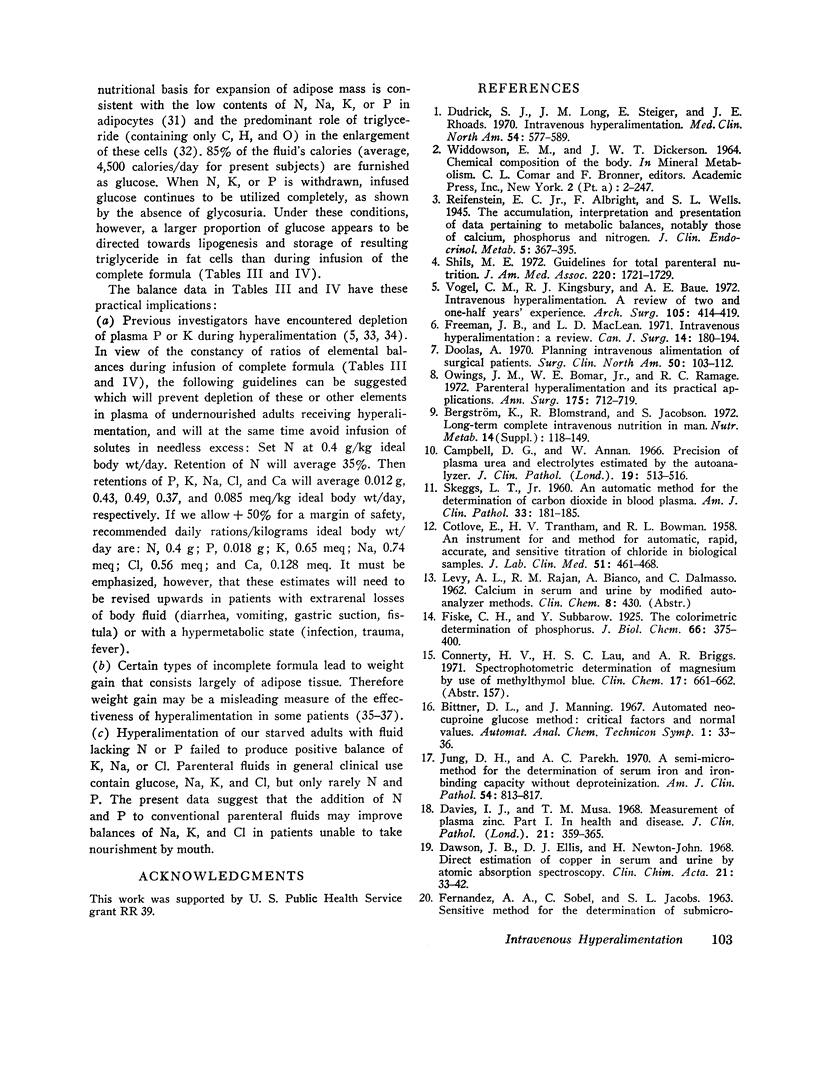
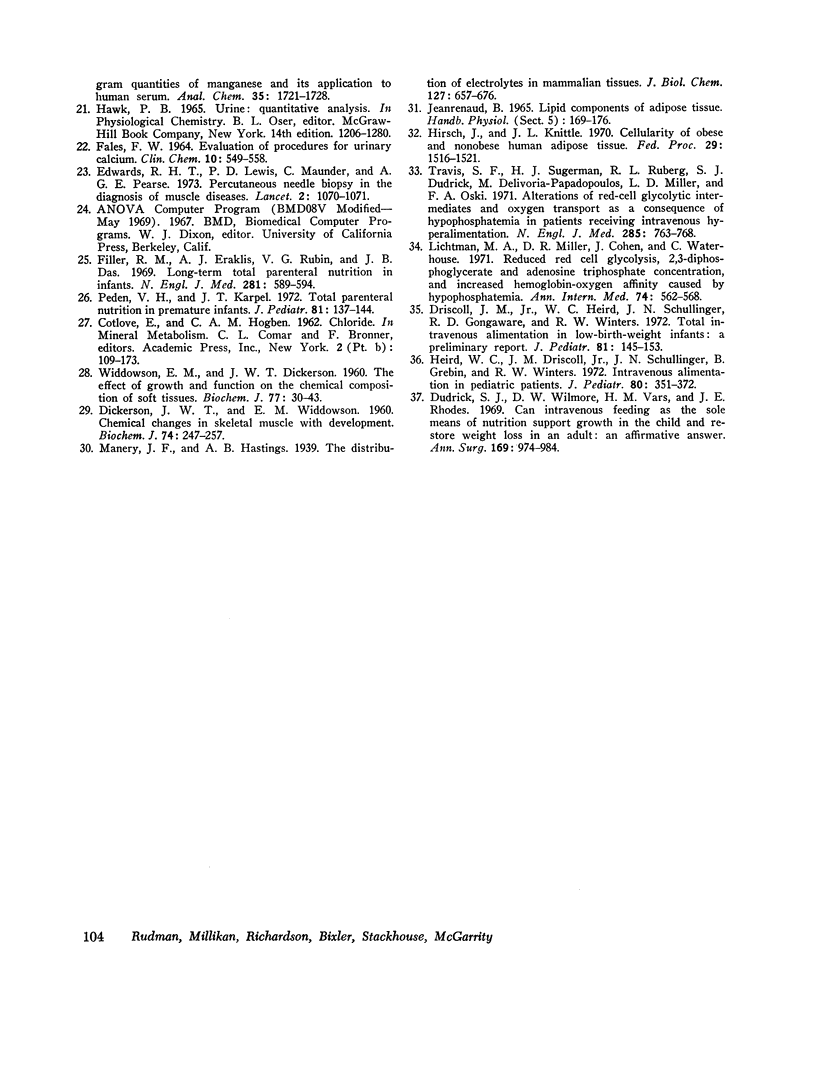
Selected References
These references are in PubMed. This may not be the complete list of references from this article.
- Bergström K., Blomstrand R., Jacobson S. Long-term complete intravenous nutrition in man. Nutr Metab. 1972;14(Suppl):118–149. doi: 10.1159/000175411. [DOI] [PubMed] [Google Scholar]
- COTLOVE E., TRANTHAM H. V., BOWMAN R. L. An instrument and method for automatic, rapid, accurate, and sensitive titration of chloride in biologic samples. J Lab Clin Med. 1958 Mar;51(3):461–468. [PubMed] [Google Scholar]
- Campbell D. G., Annan W. Precision of plasma urea and electrolytes estimated by the AutoAnalyzer. J Clin Pathol. 1966 Sep;19(5):513–516. doi: 10.1136/jcp.19.5.513. [DOI] [PMC free article] [PubMed] [Google Scholar]
- DICKERSON J. W., WIDDOWSON E. M. Chemical changes in skeletal muscle during development. Biochem J. 1960 Feb;74:247–257. doi: 10.1042/bj0740247. [DOI] [PMC free article] [PubMed] [Google Scholar]
- Davies I. J., Musa M., Dormandy T. L. Measurements of plasma zinc. I. In health and disease. J Clin Pathol. 1968 May;21(3):359–363. doi: 10.1136/jcp.21.3.359. [DOI] [PMC free article] [PubMed] [Google Scholar]
- Dawson J. B., Ellis D. J., Newton-John H. Direct estimation of copper in serum and urine by atomic absorption spectroscopy. Clin Chim Acta. 1968 Jul;21(1):33–42. doi: 10.1016/0009-8981(68)90007-7. [DOI] [PubMed] [Google Scholar]
- Doolas A. Planning intravenous alimentation of surgical patients. Surg Clin North Am. 1970 Feb;50(1):103–112. doi: 10.1016/s0039-6109(16)39036-3. [DOI] [PubMed] [Google Scholar]
- Driscoll J. M., Jr, Heird W. C., Schullinger J. N., Gongaware R. D., Winters R. W. Total intravenous alimentation in low-birth-weight infants: a preliminary report. J Pediatr. 1972 Jul;81(1):145–153. doi: 10.1016/s0022-3476(72)80394-9. [DOI] [PubMed] [Google Scholar]
- Dudrick S. J., Wilmore D. W., Vars H. M., Rhoads J. E. Can intravenous feeding as the sole means of nutrition support growth in the child and restore weight loss in an adult? An affirmative answer. Ann Surg. 1969 Jun;169(6):974–984. doi: 10.1097/00000658-196906000-00018. [DOI] [PMC free article] [PubMed] [Google Scholar]
- Edwards R. H., Lewis P. D., Maunder C., Pearse A. G. Percutaneous needle biopsy in the diagnosis of muscle diseases. Lancet. 1973 Nov 10;2(7837):1070–1071. doi: 10.1016/s0140-6736(73)92672-x. [DOI] [PubMed] [Google Scholar]
- FALES F. W. EVALUATION OF PROCEDURES FOR URINARY CALCIUM. Clin Chem. 1964 Jun;10:549–558. [PubMed] [Google Scholar]
- Filler R. M., Eraklis A. J., Rubin V. G., Das J. B. Long-term total parenteral nutrition in infants. N Engl J Med. 1969 Sep 11;281(11):589–594. doi: 10.1056/NEJM196909112811104. [DOI] [PubMed] [Google Scholar]
- Freeman J. B., MacLean L. D. Intravenous hyperalimentation: a review. Can J Surg. 1971 May;14(3):180–194. [PubMed] [Google Scholar]
- Heird W. C., Driscoll J. M., Jr, Schullinger J. N., Grebin B., Winters R. W. Intravenous alimentation in pediatric patients. J Pediatr. 1972 Mar;80(3):351–372. doi: 10.1016/s0022-3476(72)80492-x. [DOI] [PubMed] [Google Scholar]
- Hirsch J., Knittle J. L. Cellularity of obese and nonobese human adipose tissue. Fed Proc. 1970 Jul-Aug;29(4):1516–1521. [PubMed] [Google Scholar]
- Jung D. H., Parekh A. C. A semi-micromethod for the determination of serum iron and iron-binding capacity without deproteinization. Am J Clin Pathol. 1970 Dec;54(6):813–817. doi: 10.1093/ajcp/54.6.813. [DOI] [PubMed] [Google Scholar]
- Lichtman M. A., Miller D. R., Cohen J., Waterhouse C. Reduced red cell glycolysis, 2, 3-diphosphoglycerate and adenosine triphosphate concentration, and increased hemoglobin-oxygen affinity caused by hypophosphatemia. Ann Intern Med. 1971 Apr;74(4):562–568. doi: 10.7326/0003-4819-74-4-562. [DOI] [PubMed] [Google Scholar]
- Owings J. M., Bomar W. E., Jr, Ramage R. C. Parenteral hyperalimentation and its practical applications. Ann Surg. 1972 May;175(5):712–719. doi: 10.1097/00000658-197205000-00011. [DOI] [PMC free article] [PubMed] [Google Scholar]
- Peden V. H., Karpel J. T. Total parenteral nutrition in premature infants. J Pediatr. 1972 Jul;81(1):137–144. doi: 10.1016/s0022-3476(72)80393-7. [DOI] [PubMed] [Google Scholar]
- Rhoads J. E., Steiger E., Dudrick S. J., Long J. M. Intravenous hyperalimentation. Med Clin North Am. 1970 May;54(3):577–589. [PubMed] [Google Scholar]
- SKEGGS L. T., Jr An automatic method for the determination of carbon dioxide in blood plasma. Am J Clin Pathol. 1960 Feb;33:181–185. doi: 10.1093/ajcp/33.2_ts.181. [DOI] [PubMed] [Google Scholar]
- Shils M. E. Guidelines for total parenteral nutrition. JAMA. 1972 Jun 26;220(13):1721–1729. [PubMed] [Google Scholar]
- Travis S. F., Sugerman H. J., Ruberg R. L., Dudrick S. J., Delivoria-Papadopoulos M., Miller L. D., Oski F. A. Alterations of red-cell glycolytic intermediates and oxygen transport as a consequence of hypophosphatemia in patients receiving intravenous hyperalimentation. N Engl J Med. 1971 Sep 30;285(14):763–768. doi: 10.1056/NEJM197109302851402. [DOI] [PubMed] [Google Scholar]
- Vogel C. M., Kingsbury R. J., Baue A. E. Intravenous hyperalimentation: a review of two and one-half years' experience. Arch Surg. 1972 Sep;105(3):414–419. doi: 10.1001/archsurg.1972.04180090019005. [DOI] [PubMed] [Google Scholar]
- WIDDOWSON E. M., DICKERSON J. W. The effect of growth and function on the chemical composition of soft tissues. Biochem J. 1960 Oct;77:30–43. doi: 10.1042/bj0770030. [DOI] [PMC free article] [PubMed] [Google Scholar]


